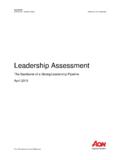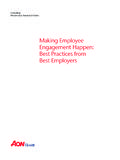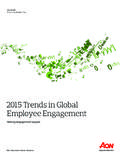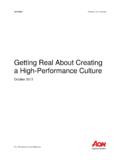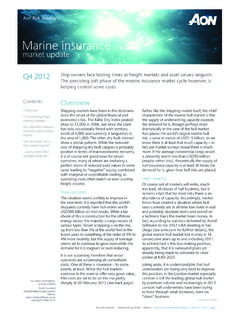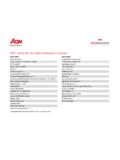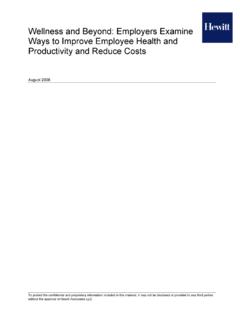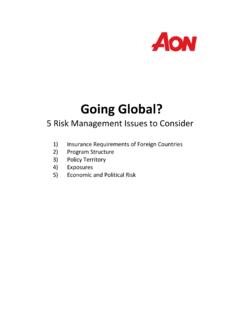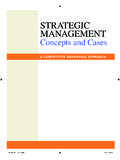Transcription of Hewitt Point of View: Engagement and Culture: …
1 Engagement and culture : engaging talent in turbulent TimesWhen businesses confront an external environ-ment characterized by challenge and confusion, why should they be interested in human capital management? The answer is simple. In times of uncertainty and change, it is crucial to have a clear sense of direction. The lack of engaged and committed employees, efficient processes and systems and a culture to support a produc-tive workforce could lead to a potential collapse. Recession or not, it is imperative to understand and implement effective and proven human capital management practices. In this Position brief, we present a summary of how engage-ment and culture can work together to create a successful and resilient workforce that can drive performance in turbulent tough times, increased cost pressures and uncertainty cause anxiety among employees, resulting in a greater need for process efficiency and alignment.
2 How can companies continue to engage employees and encourage positive performance? To understand the relationship further, we examined employee Engagement and culture in 900 organizations across 8 markets. The study compared the scores of companies that were leading performers with mid-tier and bottom organizations. The results of this study are highlighted in this position brief and help Point of ViewWhat Are Engagement and culture ?For the purpose of this brief, our definitions of Engagement and culture are: Engagement Engagement is the emotional and intellectual commitment of an individual or group to build and sustain strong business performance. Hewitt s Engagement process goes beyond employee happiness or satisfaction by focusing on behaviors that produce results. It also focuses on the entire employee population of an organization not only on how to engage employees, but also on how to maintain Engagement among those already engaged and The behaviors and belief characteristics of an organization as exhibited by the stated and unstated rules and expectations, prevailing val-ues, norms, behaviors and systems that define an organization.
3 culture is created and maintained by leadership actions, operating systems, and processes that influence employee and organi-zational behaviors. It is often deeply embedded and slow to change, as it involves fundamental human values. Barrett s research shows that employees are at their most productive when their personal values are closely aligned with their employer s better understanding how the interplay of Engagement and culture can lead to positive performance outcomes and greater financial and Cultural Alignment Working TogetherHewitt s research demonstrates that both cultural alignment and Engagement have a proven relationship with a company s financial performance. Together, the two forces have a more positive impact on revenue than when working independently. One without the other poses a grave risk for the organization.
4 A culture that focuses on high performance can attract and engage high-potential talent who bring their strong capabilities and are also energized by the company s core values. The top engage-ment driver of high potential talent in a recent Hewitt study emerged as job fulfillment and challenge. High performance cultures create a stimulating work environment and processes where top talent are inspired and have the sup-port to provide extra effort. Among other prac-tices, they set stretch goals, assign high-impact, high-visibility projects and manage career paths of their high potentials to keep those individuals totally engaged. To understand cultural alignment, we utilize the Barrett Seven Levels of Business Functioning model. Using the model, illustrated in Figure 1, we can understand employees personal values and how they align with the organization s current culture values, and what leaders and employees aspire to in their desired culture values.
5 The results show how the organization functions now and how it needs to function to be more 2 Figure 1: Seven Levels of Business Functioning ModelCurrent and Desired Cultures Are Profiled Using:successful. Importantly, it identifies alignment and misalignment among personal and organi-zational values. In general terms, cultural align-ment can be understood by assessing the:1. Degree of overlap between employees personal values and behaviors and their view of the organization s current values and behaviors 2. Overlap between current and desired values and behaviorsHewitt s study of 900 organizations offers clear evidence that Engagement and cultural align-ment have a synergistic effect. Comparison of scores of the leading, mid-tier, and the bottom 20 organizations on the list revealed significant differences in the level of employee Engagement and cultural alignment between the two catego-ries as shown in below in Figure between personal and current values indicates that work is a positive experi-ence for employees in the leading performers and mid-tier organizations but at the bottom companies, work is at best a neutral or even negative experience.
6 In addition, there is a decline in alignment between current and desired values. This is reflected in the Engagement data where Engagement drops off from 86 in the top companies to 31 in the bottom organizations. 3 Leading PerformersMid-TierBottom 20 OrganizationsEngagement 86% 51% 31%Alignment of Personal & Current Values 3 3 2 Alignment of Current & Desired Values 9 7 6 Figure 2: Engagement and Cultural Alignment ScoresIn half of these organizations, the alignment scores for personal and current values are 0 or 1 indicating employees have a hard time coming to work and if they do show up, they are not completely present or motivated to and EntropyCultural entropy represents the degree of dysfunction in a culture .
7 It is the measure of energy devoted to or consumed by unproduc-tive work. We find a strong inverse relationship between entropy and Engagement . Entropy is created by an inconsistency or misalignment in stated values and behaviors, resulting in systems and structures that do not support efficient operations and the organization s are several causes of cultural entropy misalignment of personal values and behav-iors with the organization, misalignment of processes and structure, and a lack of mission alignment. Our research revealed that leading performers with 6 percent entropy show strong signs of healthy functioning, leading to produc-tive work, while the bottom organizations with entropy of 21 percent need to improve their systems and alignment to be productive. time spent in this state destroys employee engage-ment and value for an organization.
8 Figure 3 gives the impact of different levels of cultural entropy on the Level Impact<10% Prime Healthy functioning11% 19% Minor Issues Requiring cultural and/or structural adjustment20% 29% Significant Issues Requiring cultural and structural transformation and leadership coaching30% 39% Serious Issues Requiring cultural and structural transformation, leadership mentoring/coaching, and leadership development40% 49% Critical Issues Requiring cultural and structural transformation, selective changes in leadership, leadership mentoring/coaching, and leadership development 4 Engagement and Shared ValuesValues are often manifested in organizational and employee behaviors.
9 Values are deeply rooted ideals and beliefs that have a major influence on how individuals approach work and make decisions. Individual values are expressed through personal behavior, while corporations reflect their values through systems and pro-cesses. Values shape corporate culture , which defines an organization s competitive advan-tage in terms of being resilient and adaptive; in attracting and keeping talented people; and in building and sustaining high performance. Interestingly, the perceived difference in an organization s espoused and executed values also has an impact on individual values and employee Engagement . Values can be those that are espoused, or those that management communicates both orally and in writing and are executed, or those values which actually drive daily decisions. When values of the organi-zation are aligned with values of the individual, it guarantees superior levels of involvement and results in greater levels of accountability, trust, innovation, and performance.
10 Behaviors, systems and processes can be posi-tive or potentially limiting. For example, the positive value or behavior of achievement can push individuals to give every ounce of effort to meet and exceed company and personal goals. On the other hand, a potentially limiting system of bureaucracy or behavior of control can undermine achievement. Bureaucracy can cause rigidity and red tape, thereby stifling innovation, accountability, and high achievement. The impact of values on Engagement can be best understood by examining the shared positive values, shared limiting values, and value Positive ValuesWe examined the personal values, current culture values and desired culture values of employees across the leading performers and bottom organizations. Our analysis shows that employees in both these groups share the same top personal values and 8 of the top 10 desired values, indicating that there is a strong align-ment between values individuals support and the culture they seek when they join an orga-nization.
